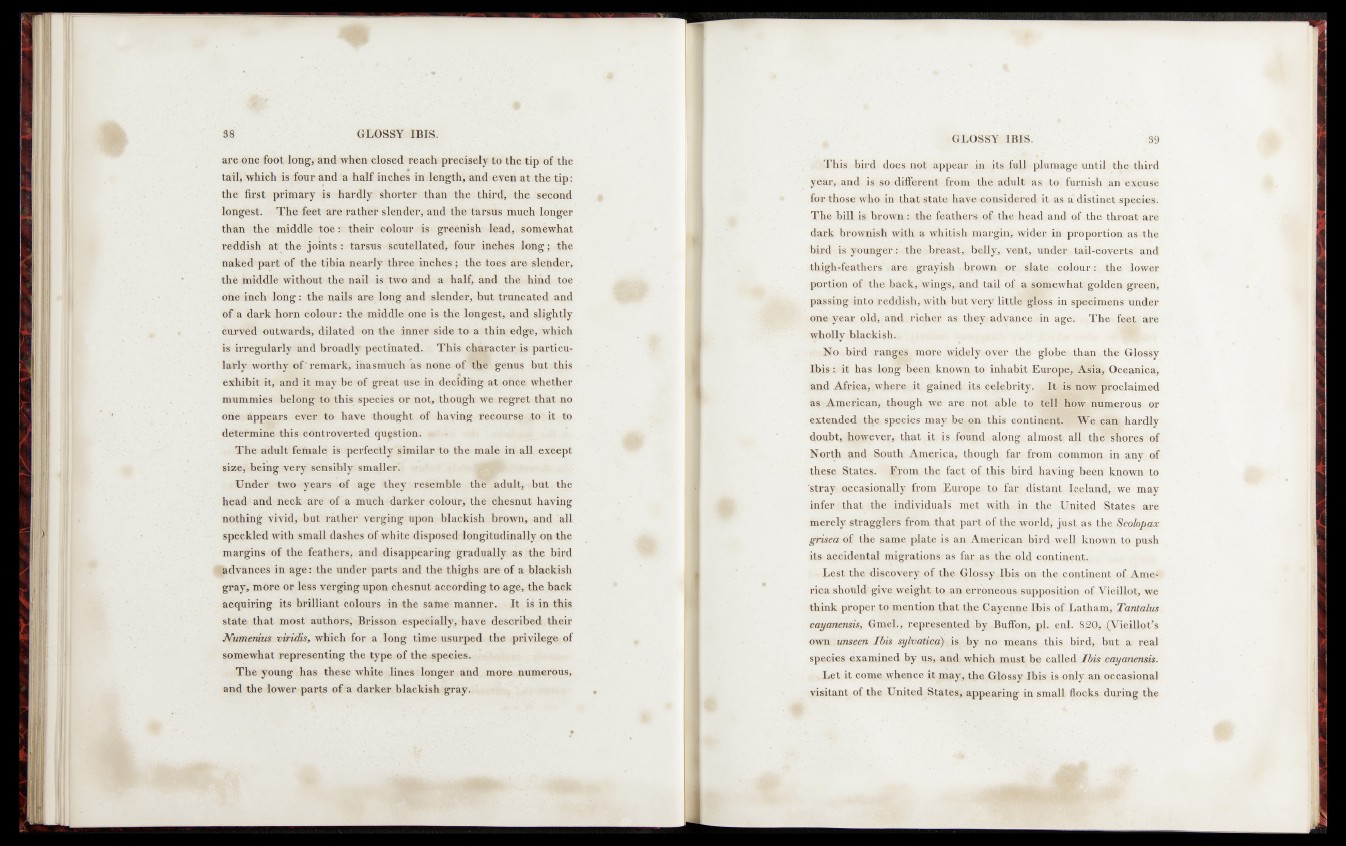
are one foot long, and when closed reach, precisely to the tip* of the
tail, which is four and a half intakes in .length, and everi at the tip:
tbfe first primary és h ardlyd Shorter than the third, the second
longest. The feet are rather slender, and the tarsus mach-Jonger
than the middle SOte S'their colour is greenish lead, somewhat
reddish at the joints : tarsus Scutellated, four inches long; fhe
naked part of the tibia nearly three inches; the toes are slender,
thè iniddle without the nail is two -and a half, and the hind toe
one inch long: the nails are long and slender, hut truncated and
of a dark horn colour: the middle one is the longest, and slightly
èurvdd outwards; dHatcd on the • inner Side to a thin edge, which
ia irregularly and broadly? pectinated. This cbajacter jp parficif*
larly worthy of* remark, inasmuch as none.ofrnP? genus but this
exhibit it, and it m ay b eo f great deciding at.ofrfee^ Whether
mummies belong tb this species or not, though we regret that no
one appears ever éto havé thought of having -recourse f o i t to
determine this controverted question. 4ft
The adult female is perfectly similar to the male in all except
siase^heing very setesibly smaller* n
Under two years of age they resemble th«?": adult, -but the
head and neck are of a mueh darker colour; the chesnut haying
nothing vivid, but rather verging upon blackish. brown, and all
speckled with small dashes of white disposeddongitudinally on the
margins of the feathers, and disappearing gradually as the bird
|&dvanoes in age: the under parts and the thighs are of a blackish
gray, more or less verging upon chesnut according to age, the back
acquiring its brilliant colours in the satne manner. It is in this
state that most authors, Brisson especially, have described their
JVumenius viridis, which for a long time usurped the privilege of
somewhat representing the type, of the species.
The young,has these white .lines longer and more numerous,
and the lower parts of a darker blackish gray.
. >This bird fpll plumagebuntil the third
year, and »is^.éiéédp the adultltas? to; furnish ian excuse
. for those whèin - that state have,%©<msidered; it as a distinet:speeies>
Th® hill J# hÉoWiiBii *hé feathers; Qf thpfthc^d^and of the- throat are
dark brownish with a whitish margins wideis, in proportion as the
bird is younger: the breast, belly, vent, under tail-coverts and
thigh-feartheTs rare .grayish i-browm .ort, slate jcn&loair^ithe lower
portion of a somewhat golden green,
passing into reddish,..with hut very littfé ||n|ss én specimens under
one-.year old, and richer as they ^dwa^icedn age. The fern,, are
wholly rhlackish.
ff i®o bird ranges, more widelysséver •the glofee^ than,, thé Glossy
Ibis :, it has Iqngnbeen known to inhabit Europe$j|l3ia,t Oceanica,
and Africa,.where it gained il^jgeJe^ritj^j It^i|,noWmoclaimeid
as Ameri#an>, thoughi:!^ are not able.. toÉ tlfiWiw pameren a or
extended th4e species may be on this continenfIPfW'e cam hardly
doubt, however,t that it is .found lafong almost* all th^snores of
North find South America* thoughj .far. from gammon in any of
these States, ]|rom the fact of this bird h.ayiagKbeen known to
‘stray occasionally from Europe; to far. djgtadt Iceland., we may
infer: that the individp^Is met with-,.in the United are
merely, stragglers from th at .part, of theworld, juséa|i;gke.s|!eó/oj,air
grisea of thé saw® plate is an Amerfean birdwell known td fush
its accidental migrations* as far as the old coptine nt,.
Lest the discovery pf th©f.GlqssywIbi^ on the eontinentof, AmeS
rica should give weight to an erroneous supposition of Yieilfot, we
think proper to mention that the Cayenpe Ibis of Latham, Tantalus.
cayanensis, GnJelt, represented by Bufifon, pi. enL .^Q^jVleilloUs
own unseen Ibis sylvatma}^s; by no: means this bird, but a real
species examined by u^andwhichr mush b® called Ibis cayanensis.
; Let it eonité.Fhence it may,tthe Glóssy Ibis is ,only, an occasional
visitant of the United States* appearing in small, flocks duping the